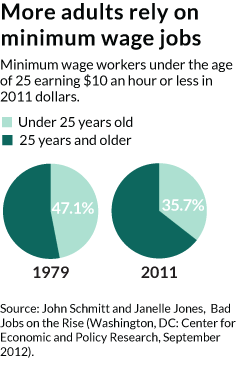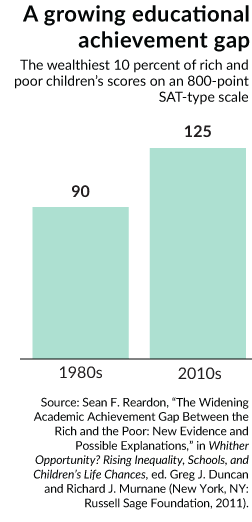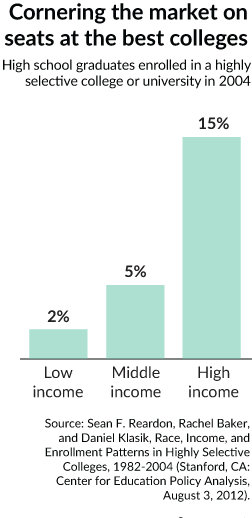The U.S. Census Bureau’s latest set of annual reports on income, poverty, and health insurance coverage in the United States demonstrates that economists and policy makers alike need to come to grips with the short- and long-term affects of economic inequality on economic growth and prosperity. The two reports present data for 2013, four and half years after the official start of the economic recovery from the Great Recession that began in December 2007 and ended in June 2009. Although there are a few bright spots, most of the data reported are dismal and the implications for income inequality are disturbing.
Most tellingly, the long-term trend lines in rising income inequality are essentially unchanged over more than four decades—across several business cycles—which means we need to understand the short- and long-term factors that result in stagnant incomes for all but the most wealthy. So let’s parse the numbers.
The first report deals with income and poverty while the second report describes health insurance coverage. The first report found that real median household income (the income of the household in the middle of the income distribution) in 2013 was stagnant for the second year in a row after having fallen for the four consecutive years after 2007. At $51,900, median household income was still 8 percent, or nearly $4,500, below its level in 2007, roughly equal to what it was nearly 20 years ago in 1995, and less than what it was in 1989. The only racial or ethnic group to experience a statistically significant increase in annual income last year was members of Hispanic households, who earned 3.5 percent more in 2013 than in 2012.
The median earnings of full-time, year-round workers did not improve, though the number of such workers increased by 2.8 million, which reflects the growth in jobs in 2013 and the gradual shift from part-time to full-time work that has been ongoing since 2010. The gap between the median earnings of men and women who worked full time, year round, was slightly reduced, but the gap was not statistically different from what it was in 2012—meaning that the data are not precise enough for the Census Bureau to state unequivocally that the earnings gap had narrowed.
Moreover, the reported improvement in the female-to-male earnings ratio, from 77 cents on the dollar in 2012 to 78 cents last year, was not just a function of an increase in the earnings of women, something we could all celebrate, but also a function of the long-term continuing stagnation in the earnings of full-time, year-round, male workers. This is a worrisome phenomenon. In fact, the median earnings of full-time, year-round male workers were no higher in 2013 than they were more than 40 years ago in 1972.
One positive finding in this year’s poverty-and-income report is that the overall poverty rate declined from 15 percent in 2012 to 14.5 percent in 2013. As the report notes, this was the first decrease in the poverty rate since 2006. However, the report cannot tell us how much of the reduction in poverty was due to an improvement in the economy and in earnings versus an increase in government transfer payments to low income households or other factors.
Almost the entire decline in poverty is attributable to a reduction in the poverty of children under the age of 18 alongside a reduction in the poverty rate of Hispanics. The poverty rate for children fell from 21.8 percent to 19.9 percent, and an estimated 1.4 million fewer children lived in poverty. The poverty rate among Hispanics dropped from 25.6 percent to 23.5 percent, indicating that nearly 900,000 Hispanics (almost 600,000 of whom were children under age18) were no longer living in poverty.
Still, some 45.3 million people were living in poverty in 2013, including 14.7 million children. And, as was true in prior years, those with the highest poverty rates include women, children, people of color, and the disabled.
The Census bureau report measures income inequality in a wide variety of ways. They include:
- Six different income ratios such as the 90th/10th ratio, which is the income of the household that is earning more than 90 percent of other households (i.e. the household at the 90th percentile) divided by the income of the household earning less than 90 percent of households (i.e. the household at the 10th percentile).
- The Gini coefficient, which summarizes the income dispersion in a number that varies from 0 to 1 and indicates greater inequality as it approaches 1.
- The Mean logarithmic deviation of income, which is a measure of the gap between the median and average income.
- The Theil index, which summarizes the dispersion of income in a number that varies from 0 to 1 with higher numbers indicating more inequality.
- The Atkinson measure, which suggests the end of the income distribution that contributed most to inequality.
None of the measures in the report indicates any reduction in income inequality in 2013 relative to 2012. By every measure, income inequality in 2013 was higher than in previous years or equally as high as has ever been reported by the Census bureau since it started collecting these data in 1967.
Here are just two cases in point. The household income at the high earning 90th percentile was 12.1 times greater than the income of the household at the low earning 10th percentile—the widest gap ever reported by the Census Bureau. Similarly, the Gini index of income inequality, one of the most commonly used measures of income inequality, was 0.476 and indistinguishable from the record high of 0.477 reported in 2012 and 2011.
It should be noted, too, that the income data reported by the Census Bureau understate the degree of income inequality. The reason: research shows that the data, derived from a survey of people, tends to overstate the incomes of low earners and understate the incomes of high earners. Thus, the true distribution of income is more uneven than indicated by the reported data.
The bottom line is that after nearly five years of economic recovery and growth in national income most Americans have not experienced an increase in their earnings while the earnings of those at the top have largely returned to their pre-recession level. The wages of men in particular have stagnated while women, children, and people of color have suffered in disproportionate numbers from the ravages of poverty. By every measure, income inequality is at a record high or on par with the record highs reported by Census in 2012 and 2011.
The second report, which deals with health insurance coverage, provides additional data that confirm the high degree of inequality revealed in the first report. Unfortunately, because of a redesign in the questions asked of respondents, it is not possible to compare results from this year’s report to prior years. Thus, the second report does not provide a perspective on whether or not inequality in health insurance coverage is growing. A different Census Bureau study, the American Community Survey, provides annual estimates of health insurance coverage that have closely followed trends in the Current Population Survey Annual Social and Economic Supplement, also commonly known as the March CPS. The American Community Survey data suggest that there have been recent improvements in health insurance: the percent of the population without health insurance fell from 15.5 percent in 2010 to 14.5 percent in 2013.
The most recent Census Bureau survey found that nearly 42 million residents, or 13.4 percent of the population, did not have health insurance coverage for the entire 2013 calendar year. The lower a household’s income, the more likely they were to lack health insurance. For example, 24.9 percent of households living in poverty had no health insurance during the year while only 5.3 percent of households earning more than $150,000 lacked insurance in 2013. Those most eligible for government provided health insurance typically had the highest insurance coverage. For instance, only 1.6 percent of those over age 65 and 7.6 percent of those under age 19 lacked insurance compared to 18.4 percent of the rest of the population. Race and ethnicity also influence coverage as nearly a quarter of all Hispanics and 1 in 6 blacks lacked health insurance coverage compared to just 1 in 10 non-Hispanic whites.
The quality of health care that people get tends to be a function of both insurance coverage and the quality of health insurance. While these data provide information about coverage, they tell us nothing about the quality of health insurance. But, from other sources we know that lower income households, blacks, and Hispanics tend to have poorer quality insurance even when they are covered which further exacerbates inequality in health care services.
A central concern of the Washington Center on Equitable Growth is that these high and persistent levels of income inequality and other forms of inequality, such as in health care, may have detrimental effects on long-term economic growth and the well-being of most Americans. Though the Census Bureau data provide a useful snapshot at a particular moment in time of the levels of income, poverty, health insurance, and income inequality, they do not tell us what is causing these levels or their economic implications.
To promote rapid and widely shared growth may require attention to both short and long-run demand and supply factors. For instance, we may need to better understand the role that demand plays in promoting business sales, creating jobs, and boosting wages. Likewise, we may need to better comprehend the productivity or long-term supply side effects of investments in the health, education, and training of people. In the coming years, Equitable Growth will analyze the data ourselves and provide annual grants to other academics across an array of social sciences in an attempt to provide answers.




